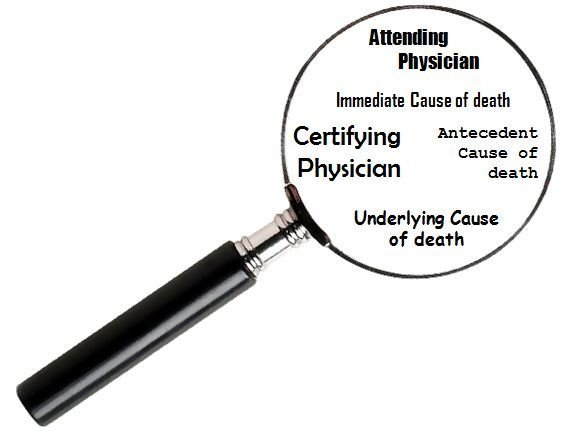Standard
terminologies
in
Death Certification

Defining
A. Physicians
i. Attending Physician
ii. Certifying Physician
B. Cause of Death
i. Underlying
ii. Immediate
iii. Antecedent
A. Physicians
i. Attending Physician
ii. Certifying Physician
- Physician attending to the patient prior to death or during the course of the terminal illness
- Physician completing Cause of Death statement on death certificate (may be the attending physician, or not)
-
Death should preferably be certified by the attending physician, that is, the attending physician and the certifying physician should be one and the same
-
However, in several instances, this may not be possible – the certifying physician does not have recourse to all the medical details of the patient whose death she/he is certifying – in these instances, best clinical judgment is to be made use of
Defining
B. Cause of Death
i. Underlying
ii. Immediate
iii. Antecedent
| Underlying cause of death | The condition that triggered the chain of events leading to death; temporally, the most remote condition; etiologically specific |
|---|
| Antecedent (or intermediate) cause of death | A disease or condition that occurred as a result of the underlying cause of death but was not the final complication or immediate cause of death |
|---|
| Immediate cause of death | The final complication resulting from the underlying cause of death, occurring closest to the time of death and directly causing death |
|---|
| Term | Definition |
|---|---|
|
|
|
| Underlying cause of death | The condition that triggered the chain of events leading to death; temporally, the most remote condition; etiologically specific |
|---|

| Antecedent/ Intermediate cause of death | A disease or condition that occurred as a result of the underlying cause of death but was not the final complication or immediate cause of death |
|---|

| Immediate cause of death | The final complication resulting from the underlying cause of death, occurring closest to the time of death and directly causing death |
|---|
In India, according to hospital death certificates,
the most common cause of death is,
“Cardio-respiratory arrest”
This is not a cause of death but a
Mode/Mechanism of death
Mode or mechanism of death
For all disease conditions, the end point of death is because of the heart or lungs or both ceasing to function in an individual.
Therefore cardiac arrest or cardio-respiratory arrest are the final mechanism/mode of death and is not to be coded as the underlying cause of death (uCoD)
Cause vs Mode of death
The sequence of events leading to death is likely to be:
| Disease |
|---|
| Complication |
|---|
| Cardio-respiratory arrest |
|---|
| Death |
|---|
In the case of cardiac arrest or cardio-respiratory arrest
-
the disease should be coded as the underlying CoD
-
and cardiorespiratory arrest is called the final mechanism/mode of death
-
the complication should be identified as the immediate CoD
Cause vs Mode of death
| Disease |
|---|
| Complication |
|---|
| Cardio-respiratory arrest |
|---|
| Death |
|---|
Some common conditions that
are not causes of death
| Term | Definition |
|---|---|
| Mode or Mechanism of death | A derangement or disturbance by which a cause of death exerts its lethal effect (e.g., cardiac arrest, respiratory arrest, cardio respiratory arrest); must not be used as an underlying cause of death |
| Term | Definition |
|---|---|
| Non-specific condition | A derangement or disturbance that has more than one possible cause (e.g., sepsis, hemorrhage, heart failure, renal failure,multi-organ failure) must not be used as an underlying cause of death |
-
Non-specific conditions such as septicemia, renal failure or respiratory failure must not be identified as the underlying cause of death
-
They are the consequence of some other disease entities and therefore they may be coded as the immediate cause of death; in all such cases a causal pathway must be constructed to identify the disease that led to these end-processes
| Term | Definition |
|---|---|
| Risk factors | Underlying determinants but not cause of death (eg. Smoking, alcoholism, etc.) must not be used as an underlying cause of death |
-
Though smoking or alcoholism may have been underlying risk factors for the development of diseases subsequently, these behaviors are identified as risk factors and not as the underlying causes of death
-
The biological abnormality arising as a consequence (eg, cancer, ischemic heart disease, alcoholic liver disease, etc.) should be identified as the underlying cause of death and not these risk behaviours per se
-
World Health Organisation (W.H.O.) also makes the suggestion on the following conditions not being preferred as underlying causes of death but to be considered as risk factors
i. For newborns :
1.Prematurity
2.Low Birth Weight
ii. For children :
1.Malnutrition
iii. For adults :
1.Hypertension
2.Diabetes
-
This means that in a person with a long-standing illness such as diabetes, the complication that triggered the sequence of events leading to death (such as diabetic nephropathy) should be listed as the underlying CoD rather than the diabetes per se
-
Similarly in children, the illness arising in a child with malnutrition (for eg. diarrhea or pneumonia) should be coded as the UCoD rather than the malnutrition
-
The above conditions may be used only in those instances when no other complications/sequelae are known to have occurred in the particular individual
-
This reasoning is based on the fact that the above conditions are so common that they would virtually then be listed as the UCoD in almost all of the adults/children/newborns
You have now come to the end of this learning activity.
Move on to your next learning activity.